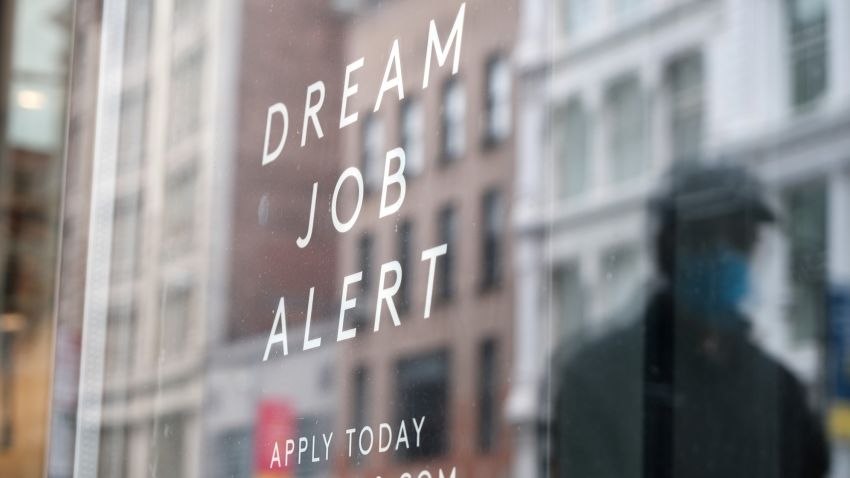The US labor market that was poised for a spring cool just got a touch of heat.
The economy added 253,000 jobs in April, according to data released Friday by the Bureau of Labor Statistics. It’s a surprising increase at a time when many indicators were pointing to a slowdown in the job market.
The unemployment rate fell to 3.4% — matching a 53-year low hit in January — from 3.5% the month before. The labor force participation rate held steady at 62.6%.
Economists were expecting job growth to decline for the third consecutive month, 180,000 jobs to be added, and for the unemployment rate to increase to 3.6%, according to Refinitiv. Only three economists of the 87 polled by Refinitiv had projected job growth at or above 253,000.
The net job gains seen in April represent a big jump from March’s tally, which was revised down to 165,000 from 236,000 jobs, BLS data shows. Some of the largest increases were in the sectors of private education and health services, professional and business services, and leisure and hospitality.
“Payrolls came in better than expected, the unemployment rate fell, and wage growth reaccelerated; all of these data points show that the labor market remains on somewhat solid footing,” Sameer Samana, senior global market strategist at Wells Fargo Investment Institute, said in a statement. “While the [Federal Reserve] has laid the groundwork for a pause at the June meeting, additional strong economic data would keep them firmly on the side of a tightening bias.”
In April, average hourly earnings trending up, rising 0.5% from the previous month and increasing to a 4.4% gain over the past year. In March, the monthly and annual measures of wage gains in the private sector was up 0.3% and 4.3%, respectively.
Despite the upside surprise, the labor market does appear to be still slowing to a more sustainable pace of growth, Gus Faucher, senior vice president and chief economist of the PNC Financial Services Group, told CNN.
February’s total was revised down as well — to 248,000 from 326,000 — resulting in average job growth of 222,000 for the past three months, BLS data shows. During the second half of last year, job growth averaged 353,000 per month.
“So we are seeing a slowing in the labor market, and that’s good news from an inflation perspective,” Faucher said. “Businesses are still trying to hire, demand for labor is still strong, but it’s not quite as strong as it was even in late 2022. For businesses, it looks like they’re finding that perhaps it’s a little bit easier to find workers now.”
The thrills and chills of filling jobs
That’s the case for one of the longest-operating businesses in Colorado.

Brenda Fishman wears many hats at Lakeside Amusement Park, a 115-year-old family-owned landmark nestled in a tiny Colorado town near the northwest edge of Denver.
On Thursday afternoon, she jumped in as switchboard operator when the phone rang.
“The person who should be answering the phone, we haven’t been able find,” said Fishman, whose grandfather purchased Lakeside back in the 1930s.
Fishman, who works in operations, has been poring through “hundreds and hundreds and hundreds” of job applications in recent weeks. Lakeside is gearing up for the summer season and its soft opening next week.
“People need work,” she said. “People aren’t getting hired, and they want to work.”
The number of applicants for this coming season is far greater than last year, she said.
That would be a positive development for Lakeside, which last year resorted to limiting food options, closing games and shutting down some rides because of staffing shortages, she said.
However, it’s not just the amount of people applying but also who’s applying for jobs that is putting a unique spin on this year’s hiring activities.
Far more adults are vying for positions, she said, as well as people looking for a second job and people who previously worked in completely unrelated fields such as nursing, dental, and mid-level management.
“This goes back to many, many decades ago when people were tightening their belts and saving up,” she said. “We did not see the same feeling when [the Great Recession] happened. This is more marked at the moment.”
Filling the gaps
Nationally, the job gains would likely have been even higher if the labor market weren’t so supply-constrained, Julia Pollak, chief economist at ZipRecruiter, said in a note.
The unemployment rate has been below 4% for more than a year, indicating a very tight labor market, she said.
“Labor force participation was flat in April, holding hiring back,” she wrote. “With few people coming in off the sidelines, new jobs went to those actively seeking employment. As a result, Black and Hispanic unemployment continued to fall, with Black unemployment hitting a new all-time low [at 4.7%].”
However, the job growth seen in April wasn’t fully broad-based, Gregory Daco, EY Parthenon chief economist, told CNN. He noted that the BLS’ diffusion index, which measures how many industries are adding jobs, measured 57.4% for last month, staying near a pre-pandemic low.
“We are still seeing growth in some sectors, but we’re also seeing other sectors that are cutting back,” he said.
Among those with net losses were wholesale trade and temporary health services.
“The continued decline in temporary help services employment may start tripping some traditional recession alarm bells, but given the rapid pace of hiring in recent years, it may simply be another sign of moderation,” Nick Bunker, head of economic research at Indeed Hiring Lab, said in a statement. “Workers, employers, and policymakers should be encouraged about the current state of affairs, but it’s unclear how much longer it can endure.”
Businesses in leisure and hospitality and health care — sectors that have wrangled with worker shortages during the recovery from the pandemic —have steadily added jobs and starting to find a better balance in the supply and demand equation, noted Patrick Combs, interim chief executive officer at the Chicago Cook Workforce Partnership. The public workforce organization in Chicago recently hosted its sixth annual Hospitality Hires Chicago job fair, where dozens of the 300-plus attendees were offered jobs on the spot.
“There was a much closer alignment to the number of people looking for work, and the number of employers looking to hire,” McCombs told CNN. “We’re definitely not at that place where we were six months to a year ago, where there was almost desperation on the side of hospitality employers to find people and where they were cutting hours or cutting down operations.
He added: “It’s looking a lot healthier, I would say for that labor market.”
Complications for the Fed
The lion’s share of recent economic data pointed to a more pronounced softening in the labor market, which has been going gangbusters during the past three years to reclaim the 22 million jobs lost at the outset of the pandemic and grow beyond that.
The BLS’ Job Openings and Labor Turnover Survey report for March showed that openings fell to the lowest level since May 2021, hiring was flat, quits dropped and layoffs spiked.
The Challenger, Gray & Christmas read on layoff announcements showed that the January-April job cuts of 337,411 was the highest total for that period going back to 2009 (excluding 2020). And weekly jobless claims have slowly trended up in recent weeks, although they remain below historical averages.
But one indicator warning of some potential heat came Wednesday, when payroll processor ADP released its monthly look at private-sector hiring and wage activity. ADP reported that private-sector employers added an estimated 296,000 jobs in April, crushing economists’ expectations for a gain of 148,000 and more than doubling the prior month’s tally of 142,000.
A continued slowdown in job growth has been anticipated given the natural course of an employment recovery as well as the effects of the Fed’s interest rates and broader uncertainty around the banking sector.
The persistent strength of the labor market, however, provides a sense of hope that a “soft landing” is still possible, Federal Reserve Chair Jerome Powell said this week, noting the path of bringing inflation down without an overwhelming rise in unemployment and subsequent recession.
“This is what a soft landing would look like, with job growth gradually slowing to a more sustainable pace,” PNC’s Faucher said. “That being said, we won’t know whether we’ve achieved a soft landing probably until the end of this year.”
And while a lot can happen and a lot of data will be released — including another jobs report — in the 40 days before the Fed’s next policymaking meeting, today’s hotter-than expected print could influence a more hawkish tilt from the central bank, which is weighing a pause after 10 straight rate hikes.
“I think this is the type of report that is one that will keep the excessively data-dependent Fed on a tightening bias,” Gregory Daco, chief economist at EY Parthenon, said in an interview with CNN. “Unfortunately, the reality today is that excessive data dependence is a very risky proposition in such a volatile macro environment.”




